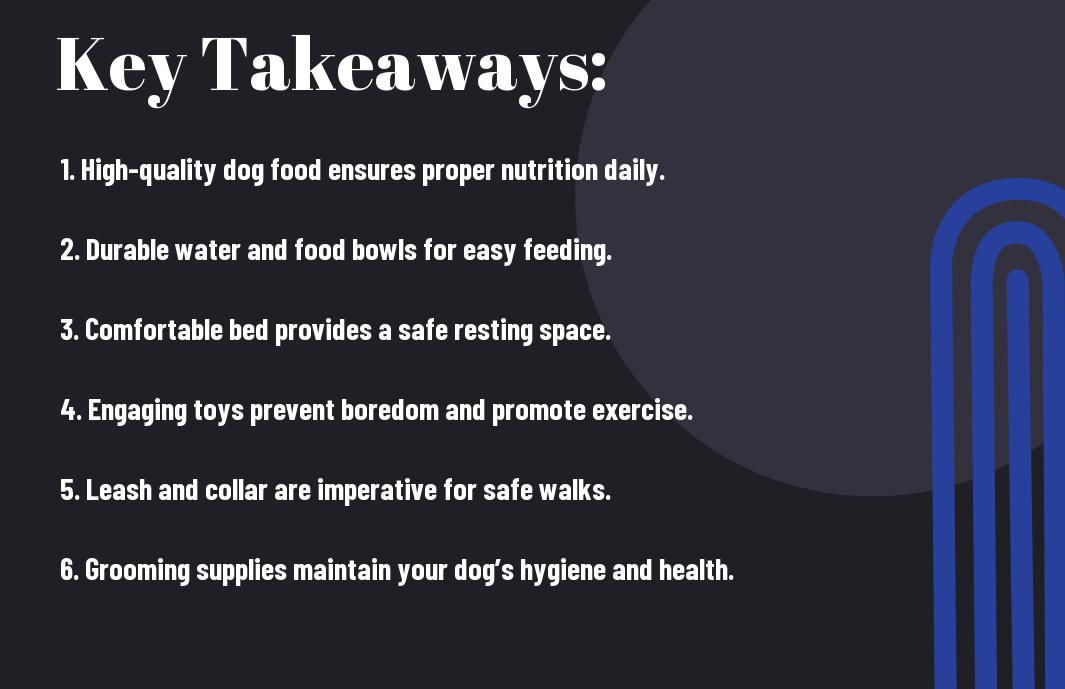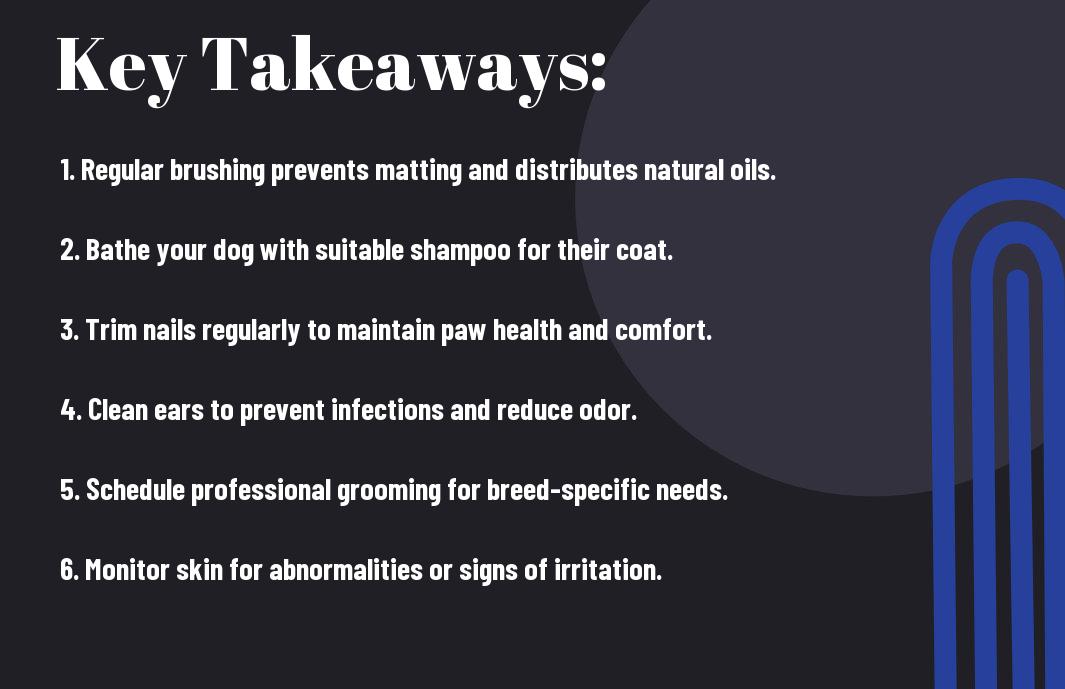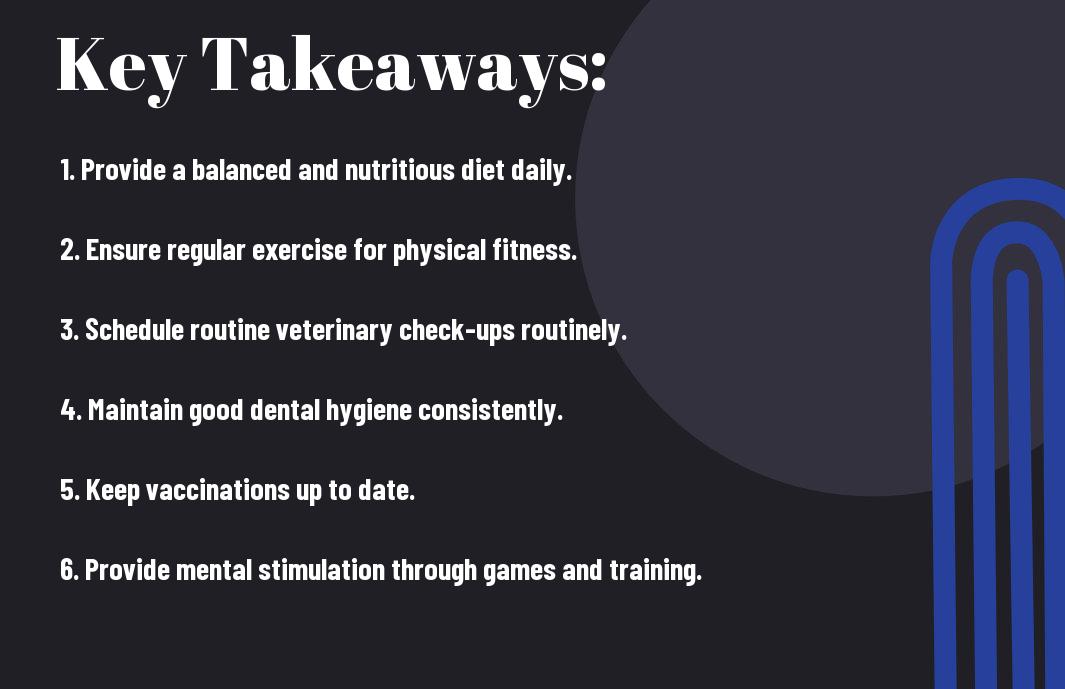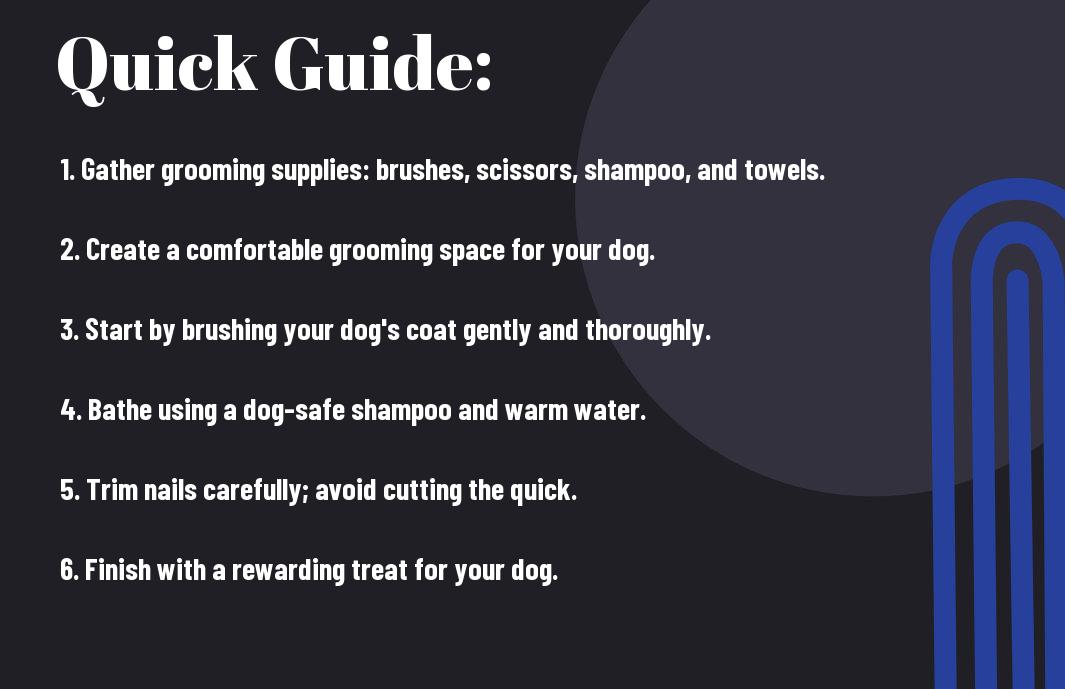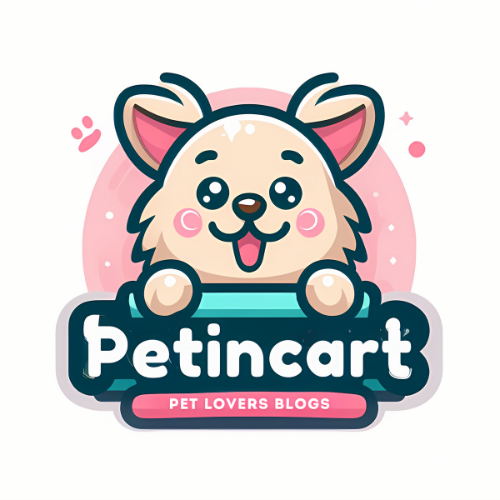With various coat types in the canine world, knowing your dog’s specific coat type is vital for effective grooming. Understanding whether your dog has a short, long, curly, or wiry coat can guide you in choosing the right tools and techniques for proper care. Proper grooming not only enhances your dog’s appearance but also plays a significant role in their health and comfort. In this post, you will gain insights into different coat types and tips on how to maintain them for a happier, healthier pet.
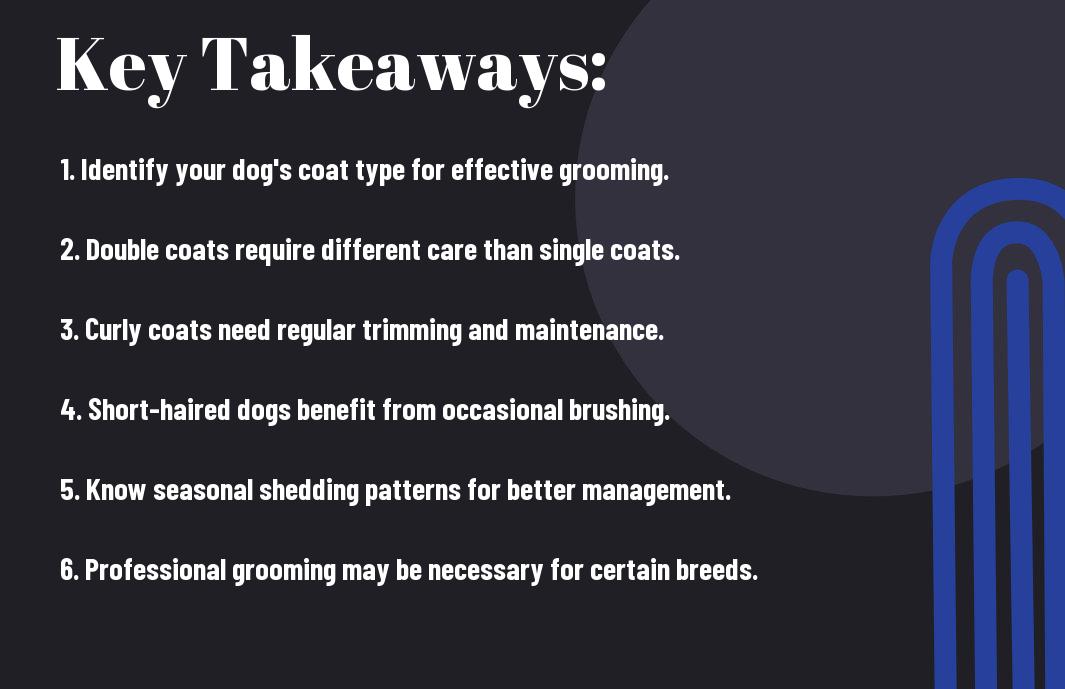
The Importance of Coat Type in Grooming
Before submerging into grooming techniques, it’s vital to understand the significance of your dog’s coat type. The type of coat affects not only the frequency and style of grooming required but also the tools and products you should use. Recognizing your dog’s specific coat type allows you to tailor the grooming experience to fit their unique needs, ensuring their comfort and health.
Different Coat Types Explained
Any dog owner should familiarize themselves with the various coat types their canines may have, as it directly influences grooming practices. Below is a table breaking down five common coat types along with their characteristics:
| Coat Type | Characteristics |
|---|---|
| Straight | Short and smooth, requires minimal grooming. |
| Wavy | Moderate length, usually needs regular brushing. |
| Curl | Dense and curly, often requires professional grooming. |
| Double coat | Thick undercoat with a longer top coat, needs seasonal shedding management. |
| Hairless | Very little hair, but regular skin care is vital. |
- Short, straight coats are the easiest to maintain.
- Wavy coats require a bit more attention with brushes.
- Curl coats often need professional grooming at times.
- Double coats require seasonal shedding strategies for best care.
- Hairless breeds need skin moisturization and protection.
Recognizing your dog’s coat type will also help determine the grooming tools you need, such as brushes, clippers, or combs. Understanding these characteristics leads to an optimal grooming routine that will keep your pup healthy and happy.
How Coat Type Affects Grooming Needs
Type of coat is equally important when assessing the grooming methods you will use. Each coat type not only varies in texture but also in growth patterns and shedding tendencies. For example, a straight coat may only require occasional brushing, while a curly coat might need regular grooming to prevent matting. Identifying your dog’s coat will allow you to choose suitable grooming tools and products, ultimately fostering a better environment for your pet.
At the end of the day, understanding how coat type affects grooming needs helps you provide your dog with the care they deserve. By adopting appropriate grooming routines tailored specifically to their coat, you can enhance your dog’s overall comfort, cleanliness, and well-being. This personalized attention will strengthen the bond between you and your furry friend while ensuring they look and feel their best.

Maintenance Requirements by Coat Type
Assuming that you want to provide your dog with the best grooming possible, it’s important to understand the specific maintenance requirements associated with their coat type. Different types of coats—short, medium, and long—come with their own sets of needs in terms of grooming frequency and techniques. By knowing how to care for your dog’s coat, you can keep them looking and feeling their best, while also ensuring their skin stays healthy.
Short Coats
Any dog with a short coat, such as Beagles or Boxers, tends to have relatively low grooming requirements. Generally, brushing your dog once a week is sufficient to remove loose hairs and distribute natural oils evenly, contributing to a shiny coat. Bathing can be performed as needed, typically every 4 to 6 weeks, especially if your dog enjoys outdoor activities that might make them dirty. Regular nail trimming and ear cleaning will also help maintain their overall hygiene.
Medium Coats
Short to medium coats, like those found on Cocker Spaniels or Siberian Huskies, require a bit more attention. Typically, these coats should be brushed two to three times a week to prevent matting and tangling. This extra brushing helps to remove loose hairs and debris, promoting a healthier coat. The bathing schedule can remain similar to that of short coats, but you may choose to do this more frequently if your dog gets particularly dirty or starts to develop an odor.
In addition to regular brushing and bathing, you’ll want to consider the use of conditioners specifically formulated for dogs with medium coats. These products can help maintain moisture levels in the fur and make brushing easier, ensuring that your grooming sessions are as effective and pleasant as possible for both of you.
Long Coats
After taking care of a long-coated dog, such as a Shih Tzu or a Maltese, you will quickly realize that they require significant grooming attention. Regular grooming is important, as daily brushing will help to prevent tangles and mats, which can be painful for your dog if allowed to persist. Bathing is typically recommended every 3 to 4 weeks, but adjusting this based on your dog’s activity level and environment can keep their coat in pristine condition.
But don’t forget that with long coats, you may want to invest in specialized grooming tools like a slicker brush or a comb, designed specifically for detangling the fur. Additionally, you should be attentive to the areas that can mat easily, such as behind the ears and under the legs, and you may even need to schedule professional grooming appointments to maintain a neat appearance and overall coat health.
Tools and Products for Grooming
Your dog’s grooming routine is only as good as the tools you use. Selecting the right brushes, combs, shampoos, and conditioners tailored to your dog’s coat type is necessary in maintaining a healthy and shiny appearance. High-quality grooming tools can make the process smoother, more enjoyable for both you and your dog, and can significantly impact the effectiveness of your grooming sessions.
Brushes and Combs
Along with regular grooming, using the right brushes and combs is vital for keeping your dog’s coat in pristine condition. Different coat types require specific tools—slicker brushes work wonders for long-haired breeds, while bristle brushes are ideal for short-haired pups. Combs also play a key role, especially in detangling and removing debris from your dog’s fur. You’ll find that by investing in a few quality grooming brushes and combs, you can address matting, shedding, and overall coat health more effectively.
Shampoos and Conditioners
For optimal coat care, selecting the right shampoos and conditioners is equally important. Products designed specifically for your dog’s coat type can enhance their natural texture and shine. Many shampoos are crafted to target common issues such as dryness, irritation, or odor, so aligning the product with your dog’s specific needs will yield the best results. Additionally, conditioners can add moisture and help with detangling, which is particularly beneficial for breeds with longer, thicker fur.
Even beyond standard grooming practices, you may want to consider special formulations that address particular concerns, such as hypoallergenic options for sensitive skin or moisturizing formulas for dogs who frequently bathe. Always check the ingredients to ensure they are safe and suitable for your dog, as some pets may have allergies or reactions to certain chemicals. The right shampoos and conditioners can not only support your dog’s coat health but also contribute to their overall comfort and happiness during grooming sessions.
Common Grooming Techniques
Unlike many people assume, grooming your dog involves several techniques that cater to different coat types and grooming needs. Understanding these techniques allows you to maintain your dog’s coat, improve their overall hygiene, and strengthen the bond you share. A consistent grooming routine is important, as it not only keeps your dog looking their best but also promotes their health and well-being.
Brushing
Grooming your dog begins with brushing, which helps remove loose hairs and debris while preventing matting. Depending on your dog’s coat type, you may need a specific brush or comb to achieve optimal results. For instance, long-haired breeds benefit from slicker brushes, while short-haired breeds often require bristle brushes. Regular brushing not only keeps your dog’s coat clean and smooth but also helps distribute natural oils, promoting a healthier shine.
Bathing and Drying
By regularly bathing your dog, you can maintain their coat’s cleanliness and overall skin health. The frequency of baths depends on your dog’s coat type and lifestyle, but it’s generally suggested to bathe them every four to six weeks. Make sure to choose a dog-specific shampoo that suits your dog’s skin type, whether it be sensitive, oily, or normal. After bathing, it’s important to dry your dog properly. You can use towels for an initial drying and follow up with a blow dryer set on a low, cool setting for a thorough finish. This careful drying process helps to prevent matting and ensures that your dog remains comfortable.
Indeed, the bathing and drying process should not be rushed. Take your time to ensure your dog enjoys the experience; after all, a positive grooming routine can lead to better cooperation in the future. Always keep an eye on your dog’s skin as well, to check for any irritation or abnormalities that may require a veterinary consultation. A well-groomed dog is not just about aesthetics; it is integral to their overall well-being, so investing time in these grooming techniques is time well spent.
Seasonal Considerations in Grooming
All dog owners should be aware that grooming needs can significantly change with the seasons. As temperatures fluctuate, your dog’s coat will often respond accordingly, which may require adjustments to your grooming routine. For example, during the warmer months, many dogs shed their undercoats to regulate their body temperature, while colder months may encourage thicker fur growth to keep them warm. Being aware of these seasonal shifts helps you make informed decisions regarding your grooming practices, ensuring your dog remains comfortable and well-maintained throughout the year.
Dealing with Shedding
On the topic of shedding, understanding your dog’s specific coat type can help in managing the amount of fur in your home. Breeds with double coats, like Huskies or Golden Retrievers, tend to shed more significantly, especially during seasonal changes. Regular brushing can help minimize the amount of fur that ends up on your furniture and floors. Using a high-quality de-shedding tool can significantly ease the process, allowing you to maintain a cleaner environment while keeping your dog’s coat healthy.
Protecting Against Weather Conditions
Above all, the effects of weather conditions on your dog’s coat should not be overlooked. In cold weather, your dog’s coat serves as insulation, so monitoring for excessive matting or tangles becomes important, as this can hinder a dog’s natural ability to stay warm. Conversely, during hot months, keeping your dog’s coat trimmed may be necessary to help them stay cool. Additionally, protective gear such as dog sweaters or raincoats can be beneficial to preserve your dog’s coat from harsh weather elements.
Even as you consider the need for protective measures against extreme weather, it’s wise to take note of your dog’s discomfort signals. If you notice your dog shivering outside in the winter or panting excessively in the summer, it may be time to reassess their grooming routine and protective wear. Regular grooming not only contributes to your dog’s overall health but ensures their comfort is maintained despite changing weather conditions.
When to Seek Professional Grooming
For many dog owners, understanding their pet’s grooming needs can be a challenge. There may come a time when home grooming isn’t enough to maintain your dog’s coat in optimal condition. This is when seeking professional grooming can be beneficial, especially for dogs with intricate coat types that require specialized techniques. Regular professional grooming appointments can help in managing your dog’s coat, ensuring that it remains healthy, matt-free, and well-maintained. Knowing when to reach out for expert help can greatly enhance your dog’s overall well-being.
Identifying Grooming Challenges
Among the many challenges you might face while grooming your dog, excessive matting, difficult-to-manage hair types, and skin issues can be significant indicators that it might be time to seek outside assistance. If your dog has a long or double coat and you notice tangles or mats that are hard to remove, a professional groomer will have the tools and experience necessary to handle these stubborn issues without causing distress to your pet. Additionally, if you find that your dog becomes anxious or stressed during grooming sessions, a qualified groomer can provide a more calming environment better suited for your pet’s needs.
Finding a Qualified Groomer
Behind every great grooming experience is a qualified professional who understands your dog’s specific requirements. When searching for a groomer, it’s important to look for someone who is not only experienced but also knowledgeable about different dog breeds and their particular coat types. Check online reviews, seek recommendations from fellow pet owners, and consider visiting the grooming facility to ensure they maintain a clean and safe environment for dogs. A good groomer will take the time to discuss your dog’s grooming needs and develop a tailored plan to keep your pet looking and feeling their best.
At the heart of finding a qualified groomer is the relationship built between you, your dog, and the groomer. Take the time to schedule a preliminary visit or consultation, allowing your dog to acclimate to the groomer and the space. Observe how the groomer interacts with your pet – a gentle approach, patience, and a keen understanding of canine body language can make all the difference. Establishing trust in this relationship will not only make grooming sessions less stressful for your dog but will also ensure they receive high-quality care each visit.
Summing up
With these considerations, understanding your dog’s coat type is crucial to ensure you provide the proper grooming care your pet needs. Each coat type, whether it’s short, long, curly, or wiry, has specific grooming requirements that contribute to your dog’s overall health and well-being. By identifying your dog’s coat type, you can select the appropriate tools, techniques, and grooming frequency, ensuring that your furry friend stays comfortable, clean, and free of mats or excess shedding.
Moreover, leveraging this knowledge will not only enhance your grooming experience but also strengthen your bond with your dog. As you become more familiar with their unique grooming needs, you can create a routine that works for both of you, making grooming sessions enjoyable rather than stressful. Investing time in understanding your dog’s coat type ultimately leads to a happier, healthier companion by promoting skin health and the natural beauty of their coat.
